The Tate NANORESTART team has been hard at work progressing the characterisation of Addendum, making the mock-ups for the cleaning test evaluations and researching Eva Hesse’s practice.
Tate Photography has now also acquired detailed images of the sculpture in normal, raking and UV lights. Using these various lights helps to understand the topography of the sculpture, and explore the presence and type of coating(s) on the surface of the work. The images acquired under UV light have confirmed the presence of a fluorescent coating applied only on the ropes.
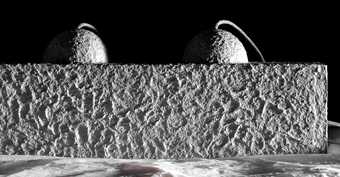
Detail of the papier mâché section in raking light. © Tate (Mark Heathcote)
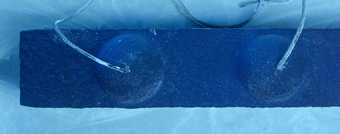
UV image showing fluorescence of ropes. © Tate (Mark Heathcote)
The scientific analysis of samples taken from the papier mâché section and from the ropes (see our previous update) has confirmed that the ropes include a third coating layer based on a pnBA/MMA acrylic emulsion.
In the meantime, Tamar has finished making all the papier mâché -based mock-ups, including some domes (the shapes at the top of the sculpture) which will be useful in the final stages of testing. Our domes were made using overturned bowls covered in cling film, then pressing the paper pulp on top.
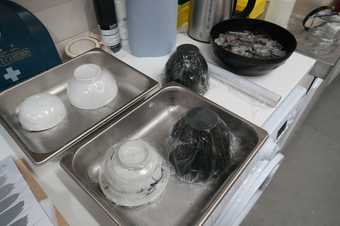
Overturned bowls used as mould to create hemispheres. © Tate
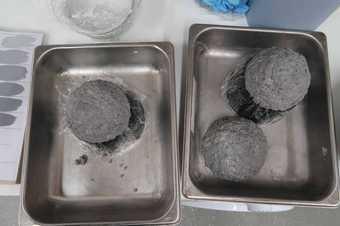
Once the samples were fully dry, the mock-ups (including the rope sections) were painted with a mixture of black and white pEA/MMA acrylic emulsion paints (Talens Rembrandt paint brand) prepared as described in our previous blog.
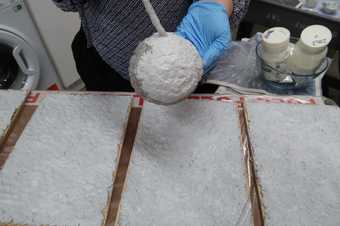
Application of grey pEA/MMA acrylic emulsion paint on the mock-ups. © Tate
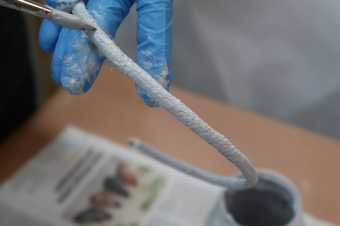
Application of grey pEA/MMA acrylic emulsion paint on the mock-ups. © Tate
Two layers of paint were applied in order to replicate the procedure used by Eva Hesse to paint the top part of the sculpture. The analysis of cross-section samples taken from the area covered in papier mâché has revealed the presence of two paint layers: a dark grey coat and a lighter grey one at the top. The images also show that the lighter grey layer on the top is highly thinned and had flowed readily into hollows in the darker grey paint. This might suggest that this layer had been brushed on somewhat aggressively, incorporating air bubbles into the paint.
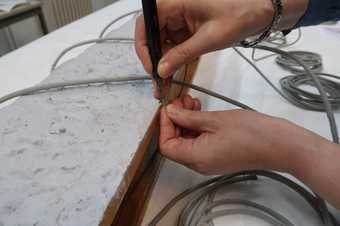
Tate Conservation Scientist Dr Joyce Townshend taking (with a thin scalpel), a small sample for cross-section analysis. © Tate
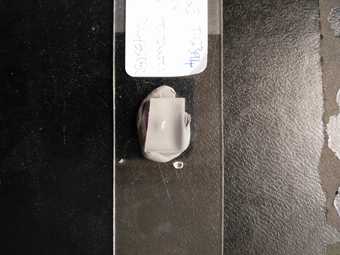
The sample is embedded into a resin and ground down to reveal a cross-section of the applied layers. © Tate
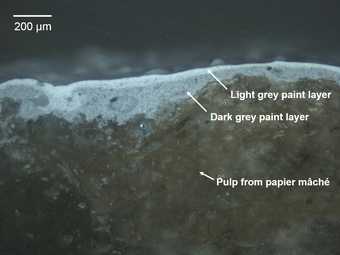
An example of a cross-section for the papier mâché sample as seen under an optical microscope in normal visible light. © Tate
The mock-ups were then transferred into an artificial light ageing chamber, with the following environmental conditions: 10000 lux, a temperature of 35°C and 30% relative humidity. The aim of exposing the mock-up samples to artificial ageing is to try to bring them, within a month, to a similar level of degradation to the sculpture as it is today.
The mock-ups were placed in the chamber for a week before the PVAc coating was applied.
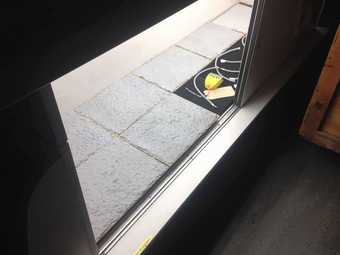
Mock-ups in the lightbox chamber. A temperature and relative humidity logger is also placed in the chamber to monitor the environment. © Tate
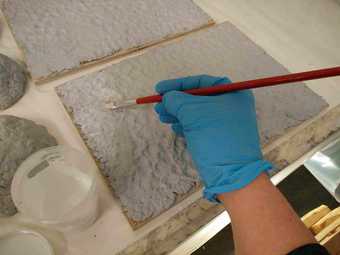
Application of PVAc coating using brush. © Tate
The mock-ups are now ageing again before they are artificially soiled to create a dirty surface for the cleaning tests. We are also investigating the application of the pnBA/MMA-based coating to the ropes, as it is possible that this could be artist applied. Unravelling this will help to inform us as to how we proceed with the cleaning and broader conservation treatment of the sculpture. It is possible that Hesse would have been able to purchase this material at an art supply store and/or through contacts. Acrylic emulsion artists’ materials were rapidly developing at this time and from our investigations thus far it appears it may have been possible for Hesse to have obtained this product commercially in 1967.
In early August 2017 we had the privilege of inviting Briony Fer, Professor of History of Art at University College of London and member of Tate’s Collection Committee, who is an expert on Eva Hesse’s work. Briony examined the work in the conservation studio. It was extremely informative to hear her thoughts on the current condition of the work, how she felt about the yellowing of the coating on the ropes, and what she felt was critical in the preservation of the sculpture. She also offered insightful information about the way Hesse created the hemispheres, apparently using a rubber ball cut in half. We discussed options as to how Addendum was constructed, and Hesse’s use of various shades of grey in various works during this period which was also informative.
Our next update will reveal more on Eva Hesse’s material practice, provide updates on the progress of the cleaning tests, and all of our other investigations; see you then!
Angelica Bartoletti, Tamar Maor, Bronwyn Ormsby
October 2017
